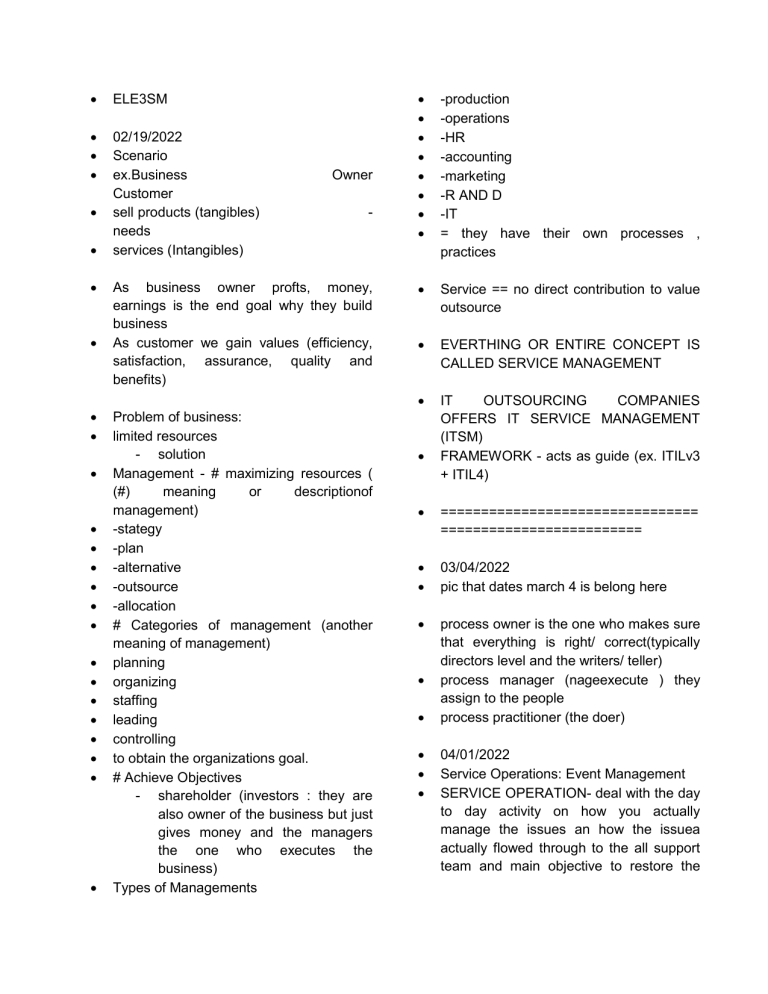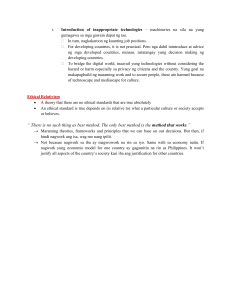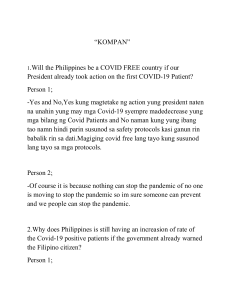
ELE3SM 02/19/2022 Scenario ex.Business Customer sell products (tangibles) needs services (Intangibles) Owner - As business owner profts, money, earnings is the end goal why they build business As customer we gain values (efficiency, satisfaction, assurance, quality and benefits) Problem of business: limited resources - solution Management - # maximizing resources ( (#) meaning or descriptionof management) -stategy -plan -alternative -outsource -allocation # Categories of management (another meaning of management) planning organizing staffing leading controlling to obtain the organizations goal. # Achieve Objectives - shareholder (investors : they are also owner of the business but just gives money and the managers the one who executes the business) Types of Managements -production -operations -HR -accounting -marketing -R AND D -IT = they have their own processes , practices Service == no direct contribution to value outsource EVERTHING OR ENTIRE CONCEPT IS CALLED SERVICE MANAGEMENT IT OUTSOURCING COMPANIES OFFERS IT SERVICE MANAGEMENT (ITSM) FRAMEWORK - acts as guide (ex. ITILv3 + ITIL4) ================================ ========================= 03/04/2022 pic that dates march 4 is belong here process owner is the one who makes sure that everything is right/ correct(typically directors level and the writers/ teller) process manager (nageexecute ) they assign to the people process practitioner (the doer) 04/01/2022 Service Operations: Event Management SERVICE OPERATION- deal with the day to day activity on how you actually manage the issues an how the issuea actually flowed through to the all support team and main objective to restore the service and find the root causes and main objective is to keeping the lights on - event - anything that may cause a system interruption - we need to monitor to prevent before the interruption occur Event Managements responsible in monitoring and detection TRESHOLD (number or limit) - baseline for triggering ALERTS(message or call to action) Common Areas to Detect Infracstructure: CPU Utilization - cpu crash mean system crash (100%(server crash)/ 95% Critical Alert/ 85% Major Alert/ 80% Major Alert/ 75% Warning/ 60% OK) Logs Monitoring - automated (Keywords Monitoring: ERR/ ERROR/ERR505) Memory Utilization - memory crash Disk Utilization (Files Storage) - it stops the processing Network Traffic - identifying if theres traffic in a network (it should be 0) Database Utilization - slows the system Database Tablespace Utilization allocation in the database stops the processing Response time - slow or fast Derived Metrics (Application-Customized) Number of Transaction failing Number of files successfully transmitted Actual amout of loses/ percent loss revenue [ price per transaction * number of transactions] Number of success rate ng API Other customized metrics Active Monitoring - if you are are reacting the alert it is active monitoring - triggered you to do something for the alert - example yung dashboard Passive Monitoring - usually use in Analytics does not need to react immediately - it monitors trends - example anomaly or change of trend like yung graph sa dashboard Event Categories Informational - does not require any action and does not present exception Warning - approaching a threshold (maghanda na kasi baka meron) Exception - actual downtime (error messages) Roles - Service Desk -Technical Management - Application Management - IT Operations Management 04/02/2022 Service Operations: Request Fulfillment Request Fulfilment - service request generic description for different demands - most of these are small changes or low risk(<--remember), frequently occuring, low cost, routinary - if high complexity/ high cost/ high risk it should be a project do not accept as service request - ex. password reset, extraction of data, forgot password, file transfer, report extraction - if routinary it has self help channels ex. forgot password (advantage cost reduction/ time reduction/ faster response of side of user) - CATEGORIES SERVICE REQUEST RFI - request for information Standard Request - repetitive Adhoc Request - specialized requests CR - change request (interface to Change Management process) may dinadaanang process bago magchange [discuss in change management] Roles - Not usually Service Operation: Problem Management (KPI: Aging Days - how long dies the Problem Record stay open) aging days should be lower -underlying cause of one or more incidents - all about identifying root cause PR - problem record - open it when theres a related incident - dont open if wala kang incident - reduce the risk/ prevent the occurance of risk/ eliminating the occuring risk TRIGGERS TO OPEN A PROBLEM RECORD repetitive incidents ( at least 3 low impact repetitive incidents to open problem record) (reactive Problem Management) A wide-spread or major incident (like hacking) - large impact incidents is high risk in the company it needs explanations (to prevent risk/ reduce the likelihood of the risk) (reactive Problem Management) Anomalies/ trends of alerts - events palang pero napapansin na naman trend of errors (if kakaibana behaviors ng warnings/alerts/ detections tracked as Incident Record) to open as to investigate the behavior (proactive Problem Management) 1PR=1 root cause category - separate steps to resolve or prevent issue code changes-> Change Request(CR) -incident/ alerts -> problem management > identify root causes 3Ps People Process Platform (Technology) Scopes - ensuring resolution in implented Information needed in Problem Record Full incident histoty (timestamps makukuha s incident ticket) Screenshots/ artifacts/ evidents Console logs/ application logs Source code Historical trends of monitoring dashboards record of workarounds done Information Generated from Problem Record Known Error Database (KEDB)- what is workarounds, documents symptoms given to Service Desk / L2/L3 Root Cause Recommended FIxes > Change Request > Change Managements - Reported to top managements Problem Management Roles Problem Process Owner - review and reates and modifies processes under Problem Management Process Manager - implements/ executes the process Problem Owner - technical person doing the investigation for Problem Record SERVICE OPERATION: ACCESS MANAGEMENT - maintainin level of securiy access to members of organization responsible of who should get what Priviledge/ Rights ( read/ write/ access) what can you do to the system or module you have access - most basic ROLE - combination of previleges and/or system they have access Priviledge-Role-Access Mapping ACCESS REVIEW: Regularly check who should get what Role/ Priviledge - since the priviledge roles change for security and risk - cannot be in different team because of check and balances Service Operation: SERVICE DESK (KPI: FCR - FIRST CALL RESOLUTION) mataas dapat FCR para di napupunta kay L2 ang ticket (MTTA - mean time to acknowledge - how fast you acknowledge the customer) usually time in terms of acknowledging your talk = low MTTA and high FCR good service desk - primary point of contact - customer management skills - deals with all user issues (incidents, requests, standard changes) - coordinates actions accross the IT organization to meet user requirements - different options(Local, Centralized, Virtual, Follow-up - they rely on script from KEDB (*INVERTED TRIANGLE IMAGE*) Service Desk Models Local - 1 channel pumapasok yung complaints and same site yung users being done if your organization is small or start-up Centralized - remote sites but 1 service desk but tyoically in headquarters Virtual - service desk distributed globally (FTS: Follow the Sun) SERVICE OPERATION: APPLICATION MANAGEMENT - DEVELOPERS, TECHNICAL SIDES, - THEY KNOW THE SYSTEM, DESIGN, FLOW OF THE SYSTEM AND FLOW OF THE USERS SIDE - APPLICATION TECHNICAL MANAGEMENT FUNCTION - SUPPORTS ITSM LIFECYCLE - GIVES RELEVANT DECISIONS - MAINFRAME SERVICE OPERATION: IT OPERATION MANAGEMENTS - LAHAT INIKUTAN NYA lahat - RESPONSIBLE FOR PERFORMING THE ORGANIZATIONS DAY TO DAY OPERATIONAL ACTIVITIES - THEY NEED TO KNOW WHAT HAPPENING TO EVERYONE - THEY ARE THJE ONE INTERPRETS KPI's - THEY ARE THE ONE GIVES IMPROVEMENTS LESSON4: SERVICE TRANSITION - all about risk management - answers what are the potential risk that might affect your operation and how should it handle or manage either prevention or migitation or risk acceptance Scope - we wanted stability - 2 pinanggalingan ng risk Normal Route or new services - normally we had developer biased since we cannot see errors during developing from existing services - changes ex. expansion, reduction and change of supplier etc. -not always the technical part of it, it could be staff, process - is to protect line environments since our goal is stability changing of platforms or discontinuation of services Importance we need to adapt quickyly to the new requirements of the business. It deals with the adaptability it helps the proper transition mas nagiging less risky impoves the success rate of changes and releases for the business and the prediction of service levels and warranties for new changed services - service level = commitments with the users to address the underline process in respect with change Service Transition V Model - typically use in validations importance for every requirement it correspond an exit criteria, KPI, document (left) right is the output of the left to show the potential risk na igegenerate ng left and naaaddress sa changes for every requirement dapat may counter part na outcome para maaddress mga potential risk Configuration Item - we will dealing configuration item = IT components (software, hardware, tao, and specs) - may process na pinagaggamitan lahat ng service transition - meron syang net effect Flow Through - all the risk came from both the production or new productions - service operation and design introduces risk in the system yung galing sa opration is little and more incremental while yung sa solution/ design mas mahaba and mas inuuna ayusin sa pagdevelop - pag maglilipat need ilista lahat ng components (software, hardware, people, operating environment, network link, IP address, derection flow, location saan nakalagay, version) because to know what is the component potentially to have an issue, tatamaan and iaddress - (CMDB) configuration management database collection of all components na nakamap sa services Change Management - is the core process of process transition - 2nd sub process - subset is change advisory group comming from representatives from access, problem, incident, technical, events and application need a visibility on operations and change kasi need nila malaman at may say sila in comes with the changes since they need to know what are the things need to know or they need to investigate - change manager - responsibile to consilidate the risk , tapatan yung risk mitigation, preparations, schedulling (calendar) - change management need to works with Service Validation and Testing and Release and Deployment Management For Example From New deployment list of errors during development - typically limited errors encountered Sevice Validation and Testing is set of people or team that is not belong to the developer who are not biased in testing, they are the one who maintain testing Service Validation and Testing purpose - maintains the defect library contains errors, issue that are encountered during testing phase 2 pwedeng mangyari one naencounter yung issue or error workaround fix para madefine agad defect library ginagamit sa KNOWLEDGE MANAGEMENT deals consolidating all of the defect nagaaccess ng knowledge management si incident, problem management pag on production para alam na agad need na ayusin or iaddress sa issue ONCE MAMEET NA YUNG CRITERIA - need na iplan paano mailipat or deploy sa live environment ROLE OF RELEASE AND DEPLOYMENT MANAGEMENT - documentation and plan - iba uling team (idealy ibang people with developer and testing) somehow comming from technical and application management Purpose nila is - alam nila yung need iprepare na steps since they are the one who knows the live environment, planning of time, date and steps on deployment (hand in hand sila) - in release and development management may tinatawag na output is method of procedure or (MOP) gantt charts and etc. planning and coordination para well coordinated sa production - they also maintain the 3-tiered environment management (Development, Testing and Staging and Live Environment) maintanimng nung versioning, and compability - Inuupdate din ni release and deployment si CMBD kasi once na irerelease or ituturn over dapat updated sila Service Asset and Configuration Management - requirements of environment, project, plans, versioning and list is completed already - sila accountable na ok yung service during live environment kaya dapat meron din sila kinukuha sa incident at problem para aware sila sa defect list, errors, and issues - MOP kailangan bumangga kay Transition and Planning Support also called R20isang augmentation team kasi sila nakikipagcoordinate sa business and othe representative sa operation sila rin ang execution/ communication/ consolidation, typically project managers Change evaluation - is handles KPI's to measures the success of transition Part2: Pre-Process Transition of Service For new Application/ services/ features - Design => Transition => Operation What if may improvements na naiidentify in normal occurrence desisyon or occurring incidents? - In operations point of view We always keeping the lights on or the operation is operating - Technical mgmt – infrastructure - Application mgmt – codes Anything you move in a code level, or touch is identify as changes - Changes/ modify setup is very important that it is record or tracked because it can translate any risk in the future - If the issues found it will be in incident records that may trigger the Change Management - Need dagdagan ng memory thread for managing changes - Trigger of change are coming from live production environment is coming from the issues or interruptions - Problems Record also connects with Change management. Technical Debts – shouldn’t necessary part of it, it depends upon it complexity

